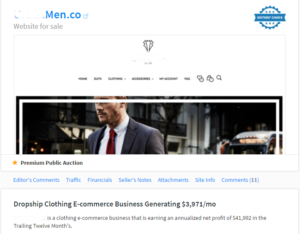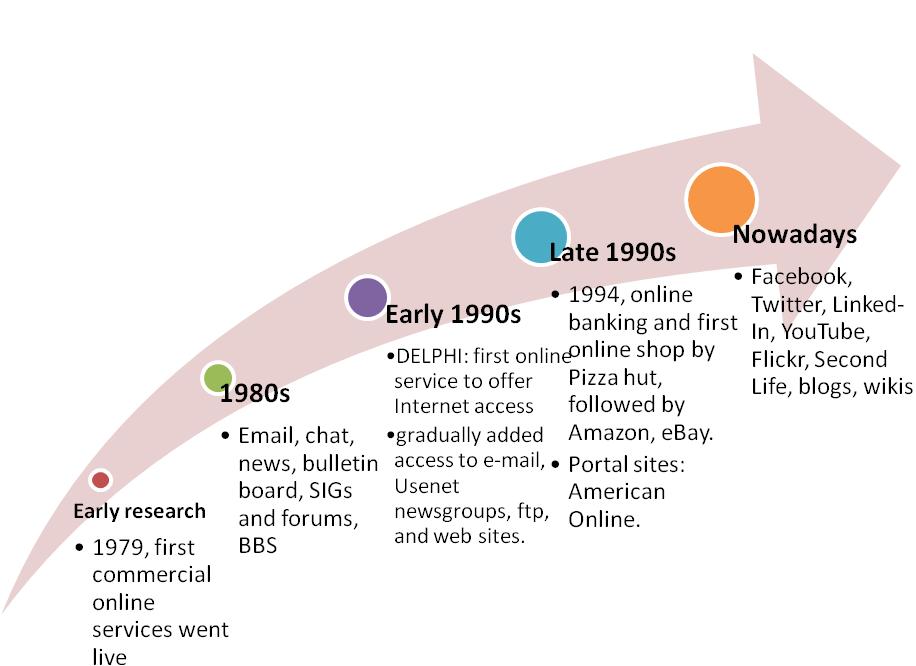Update 9/10/2016 @ 16:57
As promised I’m revealing the website that I analyzed for purchase. You can see what it went for below:
Was this a good deal? YES!!! For the buyer AND the seller since the seller basically found a niche to sell in, built the site, advertised and then flipped it. He basically sold it for its future cash flow. A win win for both parties. The buyer has no inventory to keep on hand and they gained a very valuable buyer’s list and social media accounts. Excellent addition to someone’s portfolio, I’m assuming that they know what they are doing or have someone close by who does.
As most of you know, I used to have a brick and mortar store, primarily a thrift shop although my goal was to turn it into a deeply discounted high end homegoods shop, similiar to Marshall’s and TG Max. After about 2 years I decided the overhead just wasn’t making financial sense and I closed it down. My point is, you could have several of these and not equal the hassle and overhead that a brick and mortar store has.
Anyway, below is my original post anaylizing the website for purchase. You can read more about acquiring digital assets below. Happy Building.

I’m always looking for websites that complement my existing ecommerce portfolio, so this one definitely spiked my interest. It is an urban men’s clothing site. It uses the drop ship model. I LOVE drop ship and outsourced inventory (Amazon FBA) ecommerce businesses. This means I can focus on marketing and sourcing product, instead of paying people to process and load inventory into my system. This model also eliminates the need for me (or someone I hire) to babysit the business while inventory is being processed; mainly outgoing processing for sold units.
For my flagship store, I receive inbound inventory from suppliers but 90% of it goes to Amazon FBA, who handles the entire sales process. All I need to do is get it to them. While this is nice, drop shipping is even nicer. This eliminates another step completely. It helps me take advantage of someone else’s economies of scale, something I currently do not have. Finnally, it saves a tremendous amount of money on rent and utilities by NOT having to store them in a warehouse or storefront. When I had my storefront, I knew exactly what the overhead was for each product each month, trust me when I say it was not cheap. I can not compete with most outsourcers, especially Sears and Amazon when it comes to dealing with inventory. There are added bonuses of keeping inventory at Amazon, something I will discuss in a later post.
So, as I said, this is an ecommerce clothing site catering to men. I will reveal the website and closing price when the Auction Ends in:
[wpdevart_countdown text_for_day=”Days” text_for_hour=”Hours” text_for_minut=”Minutes” text_for_second=”Seconds” countdown_end_type=”date” end_date=”07-09-2016 06:55″ start_time=”1472570296″ end_time=”0,1,1″ action_end_time=”show_text” content_position=”center” top_ditance=”10″ bottom_distance=”10″ ]Auction Over[/wpdevart_countdown]
Link to Auction: UrbanMen.co Auction
Be sure to bookmark this page or get notified via email when the auction is over.
[jetpack_subscription_form]
First a vocabulary review for those of you who are new to my WouldIBuyIt ecommerce posts:
- Drop Ship From Wikipedia: dropshipping is a supply chain management method in which the retailer does not keep goods in stock but instead transfers customer orders and shipment details to either the manufacturer, another retailer, or a wholesaler, who then ships the goods directly to the customer. As in retail businesses, the majority of retailers make their profit on the difference between the wholesale and retail price, but some retailers earn an agreed percentage of the sales in commission, paid by the wholesaler to the retailer.
- MAP Pricing The minimum price point that a manufacturer will allow you to sell their product in. You can read about MAP Pricing on the SBA website.
- SBA (Small Business Administration) An independent agency of the federal government that provides aid to small businesses. Visit their website at SBA.gov, it’s a wealth of information.
- Amazon FBA An inventory fullfillment service offered by the Ecommerce giant Amazon.com. They handle shipping and customer service.
- Annualized Profit calculated by multiplying the profit by the ratio of (number of months in a year) divided by (number of months of income data available). Basically, if you have data for only a few months, you can extropolate (for a lack of a better word) to get the expected income for the remaining of the year. It’s not an actual profit, can be misleading.
- SEO Search engine optimization. Optimizing your website so your site is as far at the top as possible on Google for your keywords.
- Market Arbitrage – buying a product in one market (such from Ebay) and selling for a higher price in another market such as Amazon.

Financial Summary
Below is a table of the monthly revenue, costs and profit. Keep in mind the Cost includes cost of goods sold (COGS) and advertising on Facebook. The owner has not done any SEO and relies strictly on Facebook and Reddit. He/she claimed that there was a spike in sales due to a Reddit post, which I find very interesting. He attributes around 100 sales to the postings he made on Reddit.
Feb 16
Revenue $1,438
Cost $435
Profit $1,003
Mar 16
Revenue $10,903
Cost $4,337
Profit $6,566
Apr 16
Revenue: $12,998
Cost $5,840
Profit $7,158
May 16
Revenue $7,863
Cost $3,039
Profit $4,824
Jun 16
Revenue $1,882
Cost $1,540
Profit$342
Jul 16
Revenue $2,170
Cost $1,066
Profit $1,104
Some initial questions I ask myself after skimming through the listing and their answers.
Can I build this site myself (with ease) and monetize it in a short amount of time? Very possibly, I am familiar with the business model I suspect they are using. I can put a website ready to take orders pretty easily, the hard part is getting traffic, which they seem to not have a problem doing so.
Does the owner accept or discourage escrow? When buying a website, it’s important you have recourse, especially when this much money is at stake. You wouldn’t buy a house without a proper title search and closing, would you? The same goes here. An escrow company makes sure you got what you paid for and he seller doesn’t run for the hills after they get your money. If they refuse escrow (even after I offer to pay for it) then I walk away, no exceptions. There is NO valid reason for NOT accepting the use of an escrow service. In this case, the seller DOES accept escrow.
Can the site be moved to a host of my choosing and is it dependent on proprietary scripts that keep you tied to the seller? Yes, very easily and NO, it does not have any propietary scripts that will tie the buyer to the seller.
Is Google Analytics installed? No, but I was able to do some extrapolation by using SEMRush and other tools.
Are they willing to give you a tour of the backend? Yes
Are there any copyright or legal issues? You don’t want to inherit anyone else’s problems. Looks like it’s not a problem with this site.
How long will it take to run the website, can you outsource it? With a little bit of marketing and getting someone to fullfill sales, this site will pretty much run on autopilot.
Will the owner consider fractional ownership? In this case, the amount is so low, it would not be necessary or even worthwhile.
Will the owner show tax returns proving income? Not applicable since the site wasn’t started until 2016.
Are they selling the company (stock sale) or just the assets of the business (asset sale)? Since there area no physical assets (sales are dropshipped) it is strictly a company sale.
Are there any social media accounts or email lists included? I’m still not sure about the whole legalities over transferring social media accounts and email lists to the new owner, but that’s what escrow is for. If they don’t do it, they don’t get paid until they do. In this case there is a Facebook page but no official email list. An email list that could be marketed to could me made from the customer shipping information. There is A LOT of value to a list. Back in 2001, I had an email list that made me money almost on demand… it was crazy. But that’s for another time.
What is the relationship with the supplier? Do they enforce MAP pricing? Are you under a volume contract? If so, is the contract transferrable? None of this applies here, the seller is basically taking advantage of market arbitrage and built a website around it where he/she owns the customer. Owning the customer data has enormous benefits.
Speaking of the customer data, is it included? If so, what details are provided? Customer data minus credit card details (payments are with paypal) is included. So the possibilities are endless on what you could do with this information as far as marketing goes. As you’ve heard many say, the money is in the list.
What are the average profit margins? 40% to 50%
What’s the average refund rate? 5%
Willing to sign a non compete contract? Yes. This is important, you don’t want someone just flipping this site to you then becoming a direct competitor of yours.
So after I ask these initial questions and am satisfied with the answers, I dive into the math.
You are basically buying the future cash flow of the business and the digital assets, assuming the latter are worth anything in and of themselves. For example, an app may not have any earnings per se (it’s just an idea and a bunch of code) but how you market it could make it more valuable, so in that case you do not have numbers to go by on the future cash flow.
When I consider a website for purchase I like to use a Risk Adjustment. I adjust my numbers by the percentage likelihood that it will lose it’s earnings substantially at any given time, thus the risk adjustment.
I also use a discount rate. This will tell us what the future cash flow is in today’s dollars. There are a few ways to determine this number based on what you are doing. If you are borrowing the money, then the discount rate will be the interest rate you are paying. If you are paying cash, it is the rate of return you would expect to receive in something else (I’m conservative here). If all else fails, I put in what the cash is worth to me, is it worth at least 15%, 10%?? It will be different for each person, but these two numbers are VERY important.
Combining the numbers above we get the Risk Adjusted Discount Rate. I’ll plug them in later, but first I want to discuss revenue, expenses then perpetuity valuation.
As with with any investment, you need to be concerned with the revenue and expenses. In the case of buying a website you need to get confirmation of the earnings, not just screenshots. In the case of this website, you can verify visually (using teamviewer, paying attention to the URL’s) their records on Paypal.
Finally, after crunching all the above numbers I get a perpetuity valuation. This is the MAXIMUM I will pay for a website, with rare exceptions. This evaluation is different based on whether I want to sell the digital asset or keep it. If my intentions are to keep it long term, I will add the numbers beyond 3 years…
So for the website in question, we only have 7 months worth of data.
Purchase Price: 10000 (max I’d pay)
Risk Adjustment: 30% (the % risk that the site will zero out and die)
Discount Rate: 16% (what I’d expect on a typical investment of mine)
______________________
Risk Adj Discount Rate: 46%
so…
Year 1 Cash Flow: $22,283 ; Discounted: $15,330.82
The value I came up with is $48,658.69 That is with the current revenue staying the same and not really doing anything with it excepting continuing to market on Facebook… there are a lot of other factors, but this is definitely one I’d take a deeper look into if and when I had the resources to purchase it.
so….
Would I buy it? YES, at the max price I stated.
Would I “fix it” up? YES – most definitely.
Will I tell you how I’d fix it up? NO, NEVER.
Would I flip or keep it? I’d probably keep it for a couple of years before cashing out.
That’s it!
If you want to see other “Would I Buy It?” valuations, be sure to sign up for my email list to get notified when I post.
Also, I will be discussing Getting a Cash Advance on your Inventory stored at Amazon in a future post.
[jetpack_subscription_form]




